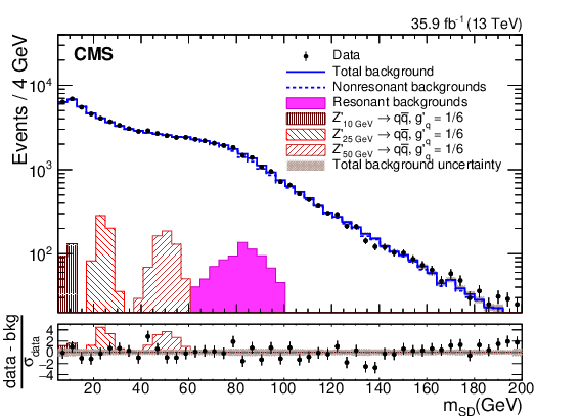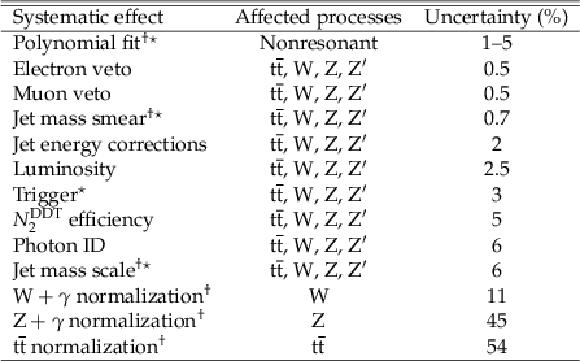

Compact Muon Solenoid
LHC, CERN
| CMS-EXO-17-027 ; CERN-EP-2019-068 | ||
| Search for low-mass quark-antiquark resonances produced in association with a photon at $\sqrt s = $ 13 TeV | ||
| CMS Collaboration | ||
| 24 May 2019 | ||
| Phys. Rev. Lett. 123 (2019) 231803 | ||
| Abstract: A search for narrow low-mass resonances decaying to quark-antiquark pairs is presented. The search is based on proton-proton collisions events collected at 13 TeV by the CMS detector at the CERN LHC. The data sample corresponds to an integrated luminosity of 35.9 fb$^{-1}$, recorded in 2016. The search considers the case where the resonance has high transverse momentum due to initial-state radiation of a photon. To study this process, the decay products of the resonance are reconstructed as a single large-radius jet with two-pronged substructure. The signal is identified as a localized excess in the jet invariant mass spectrum. No evidence for such a resonance is observed in the mass range 10 to 125 GeV. Upper limits at the 95% confidence level are set on the coupling strength of vector resonances decaying to quark pairs. The results obtained with this novel technique provide the first direct constraints on quark-antiquark resonance masses below 50 GeV obtained at a hadron collider. | ||
| Links: e-print arXiv:1905.10331 [hep-ex] (PDF) ; CDS record ; inSPIRE record ; CADI line (restricted) ; | ||
| Figures | |

png pdf |
Figure 1:
The soft drop [39,40] jet mass distribution of the signal region after the main background estimation fit is performed. The nonresonant background is indicated by a dashed line, while the total background composed of the sum of this nonresonant background and the resonant backgrounds is shown by the solid line. Representative signals are plotted for comparison. The bottom panel shows the difference between the data and the final background estimate, divided by the statistical uncertainty of the data in each bin. The shaded region represents the total uncertainty in the background estimate in each bin. |

png pdf |
Figure 2:
Upper limits at 95% CL on the coupling strength $g^\prime _ {\mathrm {q}}$ of $ \mathrm{Z}' \to {{\mathrm {q}} {\overline {\mathrm {q}}}} $. The observed limit is shown as a solid black line, while the expected limit is dashed. The green (dark) and yellow (light) bands represent 1 and 2 standard deviation intervals. Limits from other searches and the indirect constraint from measurements of the ${\Upsilon}$ and Z boson decay widths [18] are also shown. |
| Tables | |

png pdf |
Table 1:
The systematic uncertainties included in the computation of the limit on the coupling strength of Z' to quarks. Parameters denoted by the $\star $ symbol affect both the shape and normalization of the affected processes; otherwise only the normalization is modified. The parameters affecting normalizations have log normal priors, and those affecting the shape have Gaussian priors, unless marked with the $\dagger $ symbol, which denotes that this parameter was floating and constrained by the final simultaneous fit of the passing and failing distributions. |
| Summary |
| In summary, a search for a low mass Z' resonance decaying to $\mathrm{q\overline{q}}$ pairs has been presented, using data from proton-proton collisions at the LHC with a center-of-mass energy of 13 TeV. Jet substructure and decorrelation techniques are implemented to search for narrow resonances over a smoothly falling background of the jet groomed mass. No significant excess is observed above the standard model expectation. Upper limits are placed on the quark coupling strength $g'_{\mathrm{q}}$ of Z' bosons with masses between 10 and 125 GeV. Below 50 GeV, the results obtained with this novel technique probe the lowest diquark resonance masses reached by a hadron collider. |
| References | ||||
| 1 | D. Abercrombie et al. | Dark matter benchmark models for early LHC Run-2 searches: Report of the ATLAS/CMS dark matter forum | 1507.00966 | |
| 2 | G. Busoni et al. | Recommendations on presenting LHC searches for missing transverse energy signals using simplified $ s $-channel models of dark matter | 1603.04156 | |
| 3 | L. Randall and R. Sundrum | An alternative to compactification | PRL 83 (1999) 4690 | hep-th/9906064 |
| 4 | L. A. Anchordoqui et al. | Dijet signals for low mass strings at the Large Hadron Collider | PRL 101 (2008) 241803 | 0808.0497 |
| 5 | S. Cullen, M. Perelstein, and M. E. Peskin | TeV strings and collider probes of large extra dimensions | PRD 62 (2000) 055012 | hep-ph/0001166 |
| 6 | P. H. Frampton and S. L. Glashow | Chiral color: An alternative to the standard model | PLB 190 (1987) 157 | |
| 7 | R. S. Chivukula, A. Farzinnia, E. H. Simmons, and R. Foadi | Production of massive color-octet vector bosons at next-to-leading order | PRD 85 (2012) 054005 | 1111.7261 |
| 8 | E. H. Simmons | Coloron phenomenology | PRD 55 (1997) 1678 | hep-ph/9608269 |
| 9 | U. Baur, M. Spira, and P. M. Zerwas | Excited quark and lepton production at hadron colliders | PRD 42 (1990) 815 | |
| 10 | UA1 Collaboration | Two jet mass distributions at the CERN proton - anti-proton collider | PLB 209 (1988) 127 | |
| 11 | UA2 Collaboration | A search for new intermediate vector mesons and excited quarks decaying to two jets at the CERN $ \bar{p} p $ collider | NPB 400 (1993) 3 | |
| 12 | CDF Collaboration | Search for new particles decaying into dijets in proton-antiproton collisions at $ \sqrt{s} = $ 1.96 TeV | PRD 79 (2009) 112002 | 0812.4036 |
| 13 | D0 Collaboration | Search for new particles in the two jet decay channel with the D0 detector | PRD 69 (2004) 111101 | hep-ex/0308033 |
| 14 | ATLAS Collaboration | Search for new phenomena in dijet events using 37 fb$^{-1}$ of pp collision data collected at $ \sqrt{s}=$ 13 TeV with the ATLAS detector | PRD 96 052004 | 1703.09127 |
| 15 | CMS Collaboration | Searches for dijet resonances in pp collisions at $ \sqrt{s} = $ 13 TeV using data collected in 2016. | CMS-PAS-EXO-16-056 | CMS-PAS-EXO-16-056 |
| 16 | ATLAS Collaboration | Search for low-mass resonances decaying into two jets and produced in association with a photon using pp collisions at $ \sqrt{s} = $ 13 TeV with the ATLAS detector | PL(2019) | 1901.10917 |
| 17 | CMS Collaboration | Search for low mass vector resonances decaying into quark-antiquark pairs in proton-proton collisions at $ \sqrt{s} = $ 13 TeV | JHEP 01 (2014) 97 | CMS-EXO-17-001 1710.00159 |
| 18 | B. A. Dobrescu and C. Frugiuele | Hidden GeV-scale interactions of quarks | PRL 113 (2014) 061801 | 1404.3947 |
| 19 | CMS Collaboration | The CMS trigger system | JINST 12 (2017) P01020 | CMS-TRG-12-001 1609.02366 |
| 20 | CMS Collaboration | The CMS experiment at the CERN LHC | JINST 3 (2008) S08004 | CMS-00-001 |
| 21 | CMS Collaboration | Particle-flow reconstruction and global event description with the CMS detector | JINST 12 (2017) P10003 | CMS-PRF-14-001 1706.04965 |
| 22 | CMS Collaboration | Performance of photon reconstruction and identification with the CMS detector in proton-proton collisions at $ \sqrt{s} = $ 8 TeV | JINST 10 (2015) P08010 | CMS-EGM-14-001 1502.02702 |
| 23 | M. Cacciari, G. P. Salam, and G. Soyez | FastJet user manual | EPJC 72 (2012) 1896 | 1111.6097 |
| 24 | M. Cacciari, G. P. Salam, and G. Soyez | The anti-$ {k_{\mathrm{T}}} $ clustering algorithm | JHEP 04 (2008) 063 | 0802.1189 |
| 25 | D. Bertolini, P. Harris, M. Low, and N. Tran | Pileup per particle identification | JHEP 10 (2014) 059 | 1407.6013 |
| 26 | CMS Collaboration | Determination of jet energy calibration and transverse momentum resolution in CMS | JINST 6 (2011) 11002 | CMS-JME-10-011 1107.4277 |
| 27 | CMS Collaboration | Identification of heavy-flavour jets with the CMS detector in pp collisions at 13 TeV | JINST 13 (2018) P05011 | CMS-BTV-16-002 1712.07158 |
| 28 | B. A. Dobrescu and F. Yu | Coupling-mass mapping of dijet peak searches | PRD 88 (Aug, 2013) 035021 | 1306.2629 |
| 29 | J. Alwall et al. | The automated computation of tree-level and next-to-leading order differential cross sections, and their matching to parton shower simulations | JHEP 07 (2014) 079 | 1405.0301 |
| 30 | J. Alwall et al. | Comparative study of various algorithms for the merging of parton showers and matrix elements in hadronic collisions | EPJC 53 (2008) 473 | 0706.2569 |
| 31 | P. Nason | A new method for combining NLO QCD with shower Monte Carlo algorithms | JHEP 11 (2004) | hep-ph/0409146 |
| 32 | S. Frixione, P. Nason, and C. Oleari | Matching NLO QCD computations with parton shower simulations: the POWHEG method | JHEP 11 (2007) | 0709.2092 |
| 33 | S. Alioli, P. Nason, C. Oleari, and E. Re | A general framework for implementing NLO calculations in shower Monte Carlo programs: the POWHEG BOX | JHEP 06 (2010) 043 | 1002.2581 |
| 34 | T. Sjostrand et al. | An introduction to PYTHIA 8.2 | CPC 191 (2015) 159 | 1410.3012 |
| 35 | CMS Collaboration | Event generator tunes obtained from underlying event and multiparton scattering measurements | EPJC 76 (2016) 155 | CMS-GEN-14-001 1512.00815 |
| 36 | GEANT4 Collaboration | GEANT4--a simulation toolkit | NIMA 506 (2003) 250 | |
| 37 | NNPDF Collaboration | Parton distributions for the LHC Run II | JHEP 04 (2015) 040 | 1410.8849 |
| 38 | CMS Collaboration | Performance of flavour tagging algorithms in 2016 data at 13 TeV | ||
| 39 | M. Dasgupta, A. Fregoso, S. Marzani, and G. P. Salam | Towards an understanding of jet substructure | JHEP 09 (2013) 029 | 1307.0007 |
| 40 | A. J. Larkoski, S. Marzani, G. Soyez, and J. Thaler | Soft drop | JHEP 05 (2014) 146 | 1402.2657 |
| 41 | CMS Collaboration | Measurement of the differential jet cross section as a function of the jet mass in dijet events from proton-proton collisions at $ \sqrt{s} = $ 13 TeV | JHEP 11 (2018) 113 | CMS-SMP-16-010 1807.05974 |
| 42 | A. J. Larkoski, G. P. Salam, and J. Thaler | Energy correlation functions for jet substructure | JHEP 06 (2013) 108 | 1305.0007 |
| 43 | I. Moult, L. Necib, and J. Thaler | New angles on energy correlation functions | JHEP 12 (2016) 153 | 1609.07483 |
| 44 | J. Dolen et al. | Thinking outside the ROCs: Designing decorrelated taggers (DDT) for jet substructure | JHEP 05 (2016) 156 | 1603.00027 |
| 45 | R. A. Fisher | On the interpretation of $ \chi^{2} $ from contingency tables, and the calculation of P | J. Roy. Statis. 85 (1922) 87 | |
| 46 | CMS Collaboration | CMS luminosity measurements for the 2016 data taking period | CMS-PAS-LUM-17-001 | CMS-PAS-LUM-17-001 |
| 47 | A. L. Read | Presentation of search results: the CL$ _s $ technique | JPG 28 (2002) 2693 | |
| 48 | T. Junk | Confidence level computation for combining searches with small statistics | NIMA 434 (1999) 435 | hep-ex/9902006 |
| 49 | G. Cowan, K. Cranmer, E. Gross, and O. Vitells | Asymptotic formulae for likelihood-based tests of new physics | EPJC 71 (2011) 1554 | 1007.1727 |

|
Compact Muon Solenoid LHC, CERN |

|

|

|

|

|

|